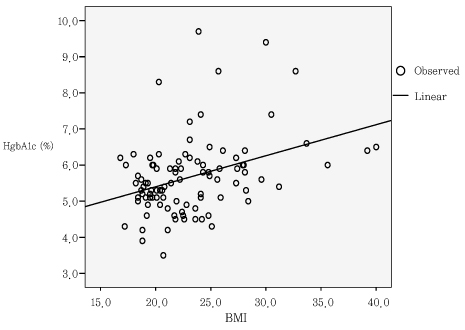Obstetric and neonatal outcomes after treatment of gestational diabetes mellitus class A1 and class A2
- Affiliations
-
- 1Department of Obstetrics and Gynecology, Samsung Medical Center, Sungkyunkwan University School of Medicine, Seoul, Korea. crroh@skku.edu
- KMID: 2273984
- DOI: http://doi.org/10.5468/kjog.2010.53.8.681
Abstract
OBJECTIVE
The purpose of this study is to compare the pregnancy outcomes of gestational diabetes mellitus (GDM) class A1 to those of GDM A2.
METHODS
We performed a retrospective analysis of 99 women who were diagnosed as GDM during prenatal care and managed until delivery from March 1996 to September 2007. Subjects were grouped into GDM class A1 and class A2. The obstetric and neonatal outcomes were compared between the two groups.
RESULTS
There were 57 cases of GDM class A1 and 42 cases of GDM class A2. Hemoglobin A1c level of GDM A2 group was significantly higher than GDM A1 group. We could not find any significant difference in obstetric (body mass index, hypertensive disorder, preterm delivery, preterm labor, preterm premature rupture of membrane) and neonatal outcomes (gestational age at delivery, macrosomia, shoulder dystocia, respiratory distress syndrome, transient tachypnea of neonate, sepsis, Apgar score, congenital anomaly) between the two groups other than increased frequency of cesarean delivery and admission to neonatal intensive care unit in GDM A2 group.
CONCLUSION
After proper management, overall pregnancy outcomes of women with GDM class A2 are comparable to those with GDM class A1.
Keyword
MeSH Terms
Figure
Cited by 3 articles
-
Prediction of Gestational Diabetes Mellitus in Pregnant Korean Women Based on Abdominal Subcutaneous Fat Thickness as Measured by Ultrasonography
Sung Hee Yang, Changsoo Kim, Hyun Sook An, Hyun An, Jin Soo Lee
Diabetes Metab J. 2017;41(6):486-491. doi: 10.4093/dmj.2017.41.6.486.Comparison of Obstetric and Neonatal Outcomes According to Oral Glucose Challenge Test in Korean Pregnant Women
Sung Hyun Yun, Sang Won Han, San Hui Lee, Yong Wook Jung, Euy Hyuk Kim
Korean J Perinatol. 2013;24(3):180-186. doi: 10.14734/kjp.2013.24.3.180.Late Preterm Infants' Outcome Born from Mothers with Positive Screening but Negative Diagnostic Test for Gestational Diabetes
Jeong Min Lee, Bo Seon Seo, Eun Sun Kim
Korean J Perinatol. 2015;26(3):200-207. doi: 10.14734/kjp.2015.26.3.200.
Reference
-
1. Metzger BE, Coustan DR. The Organizing Committee. Summary and recommendations of the Fourth International Workshop-Conference on Gestational Diabetes Mellitus. Diabetes Care. 1998. 21:Suppl 2. B161–B167.2. Moore TR. Creasy RK, Resnik R, Iams JD, editors. Diabetes in pregnancy. Maternal-Fetal medicine. Principles and practice. 2004. 5th ed. Philadelphia: Saunders;1023–1061.3. Narayan KM, Boyle JP, Thompson TJ, Sorensen SW, Williamson DF. Lifetime risk for diabetes mellitus in the United States. JAMA. 2003. 290:1884–1890.4. Sheffield JS, Butler-Koster EL, Casey BM, McIntire DD, Leveno KJ. Maternal diabetes mellitus and infant malformations. Obstet Gynecol. 2002. 100:925–930.5. Silverman BL, Rizzo TA, Cho NH, Metzger BE. Long-term effects of the intrauterine environment. The Northwestern University Diabetes in Pregnancy Center. Diabetes Care. 1998. 21:Suppl 2. B142–B149.6. American College of Obstetricians and Gynecologists. Management of diabetes mellitus in pregnancy. ACOG Technical Bulletin No. 92. 1986. Washington: American College of Obstetricians and Gynecologists.7. Crowther CA, Hiller JE, Moss JR, McPhee AJ, Jeffries WS, Robinson JS. Effect of treatment of gestational diabetes mellitus on pregnancy outcomes. N Engl J Med. 2005. 352:2477–2486.8. Jensen DM, Damm P, Sorensen B, Molsted-Pedersen L, Westergaard JG, Ovesen P, et al. Pregnancy outcome and prepregnancy body mass index in 2459 glucose-tolerant Danish women. Am J Obstet Gynecol. 2003. 189:239–244.9. Langer O, Yogev Y, Xenakis EM, Brustman L. Overweight and obese in gestational diabetes: the impact on pregnancy outcome. Am J Obstet Gynecol. 2005. 192:1768–1776.10. Johnstone FD, Nasrat AA, Prescott RJ. The effect of established and gestational diabetes on pregnancy outcome. Br J Obstet Gynaecol. 1990. 97:1009–1015.11. National Diabetes Data Group. Classification and diagnosis of diabetes mellitus and other categories of glucose intolerance. Diabetes. 1979. 28:1039–1057.12. Therasse P, Arbuck SG, Eisenhauer EA, Wanders J, Kaplan RS, Rubinstein L, et al. European Organization for Research and Treatment of Cancer. National Cancer Institute of the United States. National Cancer Institute of Canada. New guidelines to evaluate the response to treatment in solid tumors. J Natl Cancer Inst. 2000. 92:205–216.13. Langer O, Yogev Y, Most O, Xenakis EM. Gestational diabetes: the consequences of not treating. Am J Obstet Gynecol. 2005. 192:989–997.14. Garner P, Okun N, Keely E, Wells G, Perkins S, Sylvain J, et al. A randomized controlled trial of strict glycemic control and tertiary level obstetric care versus routine obstetric care in the management of gestational diabetes: a pilot study. Am J Obstet Gynecol. 1997. 177:190–195.15. Landon MB, Thom E, Spong CY, Gabbe SG, Leindecker S, Johnson F, et al. A planned randomized clinical trial of treatment for mild gestational diabetes mellitus. J Matern Fetal Neonatal Med. 2002. 11:226–231.16. Naylor CD, Sermer M, Chen E, Sykora K. Toronto Trihospital Gestational Diabetes Investigators. Cesarean delivery in relation to birth weight and gestational glucose tolerance: pathophysiology or practice style? JAMA. 1996. 275:1165–1170.
- Full Text Links
- Actions
-
Cited
- CITED
-
- Close
- Share
- Similar articles
-
- Women's Employment in Industries and Risk of Preeclampsia and Gestational Diabetes: A National Population Study of Republic of Korea
- Clinical Study of Maternal and Perinatal Complication in Pregnancy with Diabetes Mellitus
- Diabetes in pregnancy
- Comparative Study of Maternal and Perinatal Complications in Overt and Gestational Diabetes
- Childhood diabetes in India


